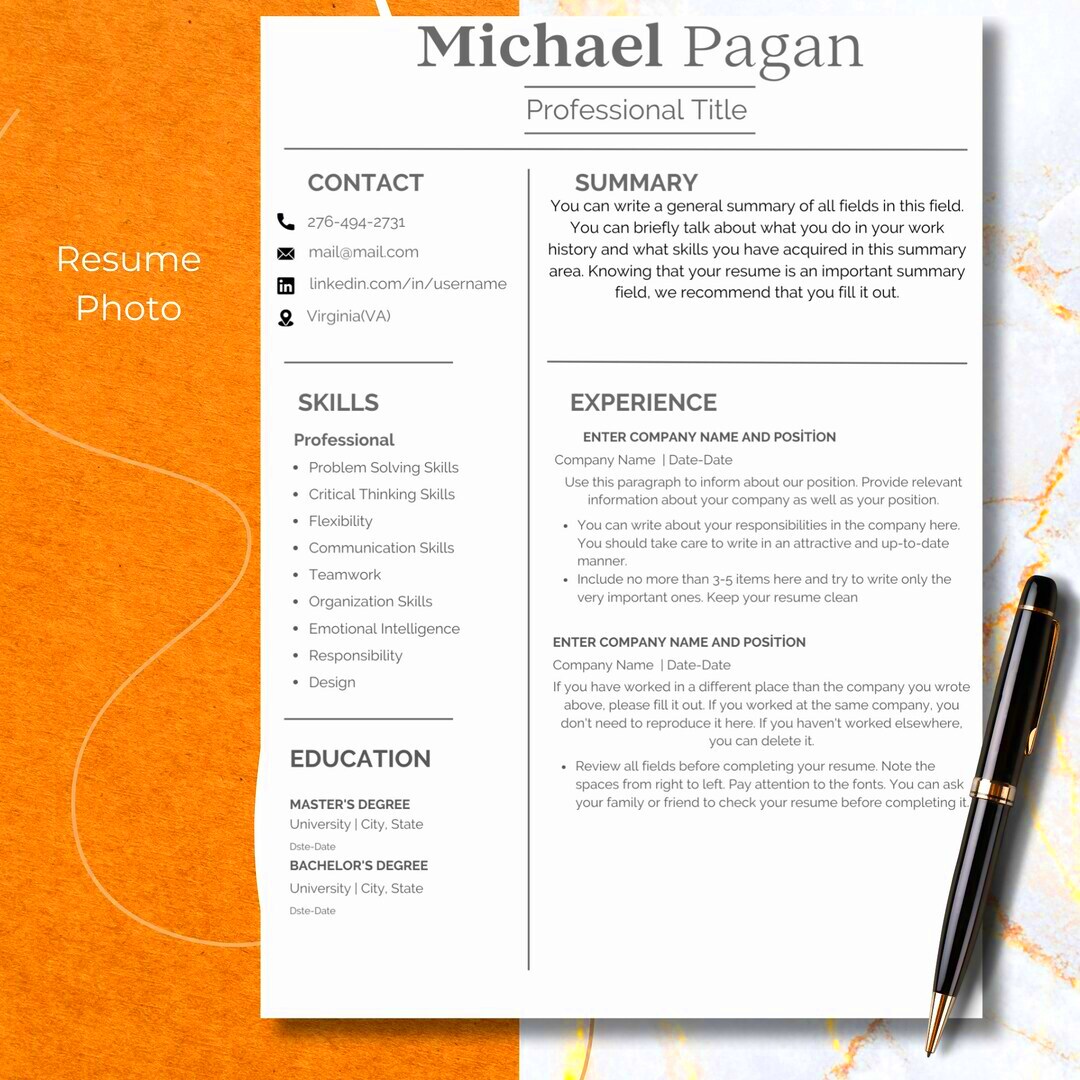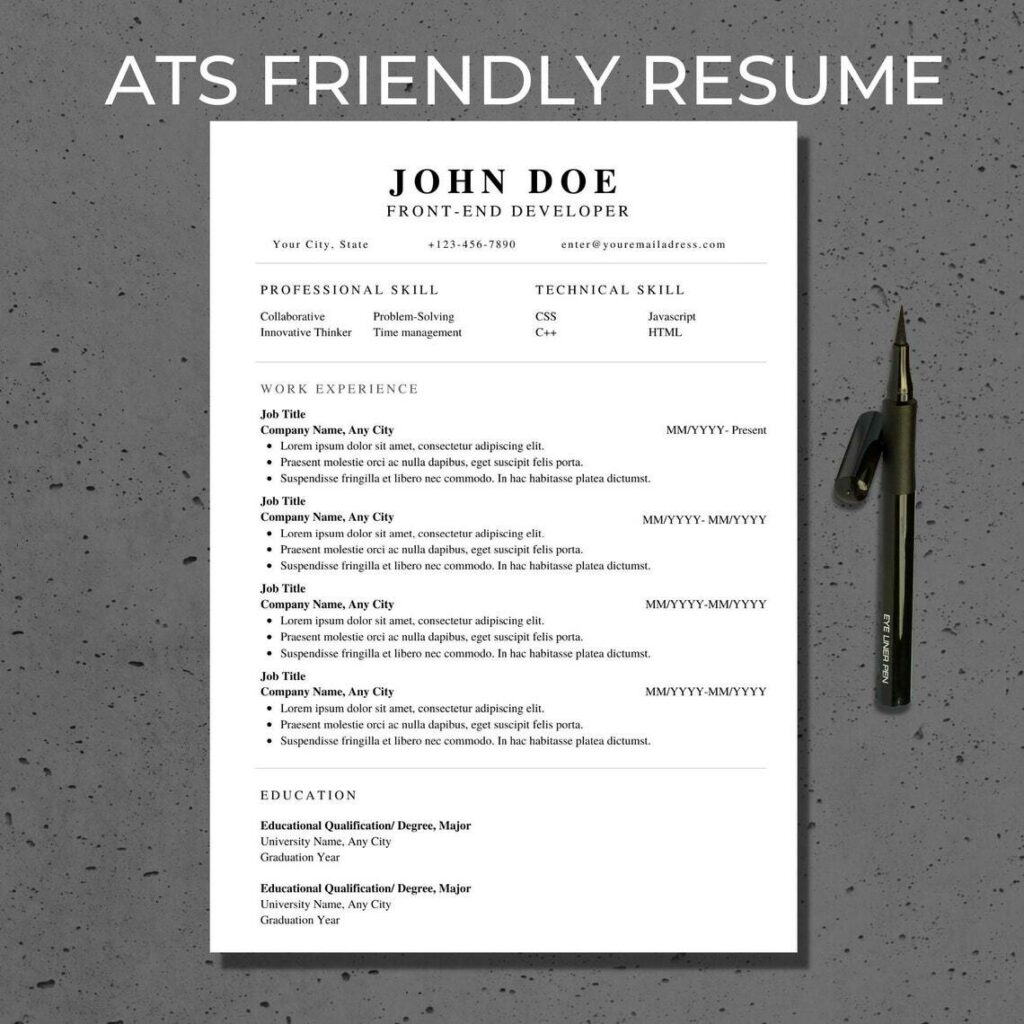In the current job landscape it's essential to have a resume that stands out. However what you may not realize is that numerous employers rely on an Applicant Tracking System (ATS) to sift through resumes. I recall during my own job search a few years back my elegantly crafted resume went unnoticed as it was rejected by the ATS. Grasping the mechanics of these systems can greatly enhance your prospects of securing that coveted position.
When it comes to applying for jobs, many companies use ATS software to screen resumes. This software looks for specific keywords and formats before passing the resumes on to a person. So even if your resume looks great, it could get rejected if it doesn't meet ATS requirements. It's important to find a between being creative and following the rules. Remember to keep in mind.
- Use standard fonts like Arial or Times New Roman.
- Stick to a simple layout without graphics or tables.
- Incorporate keywords from the job description.
Companies use Applicant Tracking Systems (ATS) to make their hiring smoother. If your resume isn't tailored for these systems you might be passing up on chances. Therefore grasping how ATS works isn't merely about following the guidelines; it's about being clever in your quest for a job.
What Are Canva Resume Templates?

Canva has changed the game when it comes to making resumes with its wide range of customizable templates that suit different industries and personal tastes. I still recall the thrill I felt when I discovered Canva while looking to update my resume. The lively colors and artistic layouts were a refreshing change from the boring Word templates I had been using before. The Canva templates are easy to use and come with features that enable anyone, regardless of their design background to craft a professional looking resume.
These templates are grouped according to various occupations, aesthetics and concepts. You can discover
- Minimalist designs for corporate jobs
- Creative layouts for artistic roles
- Elegant templates for academic positions
While Canva templates may look great it's crucial to make sure they work well with applicant tracking systems (ATS). In other words as you design an eye catching resume you should also consider how the layout can impact your chances of getting noticed in the application process.
Also Read This: Step by Step Guide to Adding a Minor to Your LinkedIn Profile
Assessing the ATS Compatibility of Canva Templates

When applying for jobs it's important to strike a balance between appearance and practicality. This is particularly relevant when using Canva templates. I've had moments where I was captivated by a beautiful design only to discover later that it might not make it through the ATS screening. So how can you determine if a Canva template is compatible with ATS? Here are some tips that I've picked up on my journey,
- Plain Text Format: Ensure the template can be exported as plain text without losing essential information.
- Avoid Graphics and Images: Graphics may look attractive but can confuse ATS. Stick to text-based designs.
- Simple Sections: Use standard headings like "Experience," "Education," and "Skills" to ensure ATS can easily navigate your resume.
Before you settle on a template, it’s a good idea to run a quick test. Take your resume and paste it into a basic text editor. If the layout looks messy or important details are missing, it’s a clue that you should pick a different template. Armed with this insight, you can choose a Canva resume template that not highlights your individuality but also increases the chances of your application catching the attention of hiring managers.
Also Read This: How to Upload Facebook Videos to YouTube
Key Features of ATS-Friendly Resumes
When it comes to creating a resume that gets through the ATS it's not just about sticking to guidelines; it's about showcasing your abilities and experiences in a way. I recall my initial effort at putting together a resume. I got so caught up in making it visually appealing that I overlooked the essentials. Sadly that version didn't make it past the ATS and I gained a lesson. Here are the important elements you should prioritize to ensure your resume successfully navigates the ATS.
- Simple Formatting: Use a clean and straightforward layout. Avoid excessive colors, borders, and graphics that can confuse the system.
- Standard Fonts: Fonts like Arial, Calibri, or Times New Roman are your best bets. They are easily readable by both ATS and humans.
- Keyword Optimization: Tailor your resume with relevant keywords from the job description. This increases your chances of being picked by the ATS.
- Clear Section Headings: Use headings like “Work Experience” and “Education” so the ATS can easily categorize your information.
- Consistent Date Formatting: Whether you use “MM/YYYY” or “Month Year,” be consistent throughout your resume to avoid confusion.
By adding these elements you can craft a CV that not only fulfills ATS criteria but also strikes a chord with hiring managers. Keep in mind it’s not solely about passing the screening process; it’s about making sure that when your CV lands in the hands of a person it leaves a memorable impact.
Also Read This: Can You Use YouTube in Airplane Mode? Tips for Offline Viewing While Traveling
How to Customize Canva Templates for ATS
When I started using Canva to make my resume I was really excited about all the different templates I could choose from. But I soon found out that making these templates work well with ATS systems needed some extra care. So let me walk you through the process with a guide on how to achieve compatibility.
- Select the Right Template: Start with a simple, text-based template that has minimal graphics. Look for options specifically labeled as “ATS-friendly.”
- Maintain Clear Sections: Ensure each section is clearly labeled. Use standard headings like “Summary,” “Experience,” and “Skills” to enhance ATS readability.
- Limit Color Use: While colors can make a resume pop, using too many can confuse the ATS. Stick to one or two complementary colors.
- Export as PDF or Word: Canva allows you to download your resume in various formats. Choose PDF or Word, as they are more likely to be ATS-compatible.
- Test Your Resume: Before applying, run your resume through an ATS simulator to see how it fares. This step can save you from potential rejections.
By tailoring your Canva templates according to these tips you can design a resume that not only looks great but also passes through Applicant Tracking Systems (ATS). It's about finding the balance between creativity and practicality and believe me putting in this work will be worth it when you secure that job interview!
Also Read This: How Much Does Getty Images Pay for Photos? Insight into Compensation Rates
Common Mistakes to Avoid When Using Canva Templates
While Canva templates offer a great way to craft a polished resume it’s important to watch out for pitfalls. I remember a friend who invested time perfecting her resume design on Canva only to have it disappear in the ATS abyss. Here are some missteps to avoid.
- Overloading with Graphics: While Canva offers beautiful graphics, too many can hinder ATS scanning. Stick to text and simple lines.
- Ignoring Job Descriptions: Failing to incorporate keywords from the job listing can lead to your resume being overlooked. Tailor your resume for each application.
- Using Uncommon Fonts: Fonts that look great might not be ATS-friendly. Stick to standard fonts to avoid misinterpretation by the software.
- Excessive Formatting: Overly complex layouts with columns and tables can confuse ATS. Keep it straightforward and linear.
- Not Proofreading: Typos or grammatical errors can create a negative impression. Always double-check your resume for mistakes.
Steering clear of these blunders can greatly improve your odds of getting through the ATS and catching the attention of a hiring manager. Keep in mind that it’s not solely about the appearance of your resume but rather how well it conveys your credentials!
Also Read This: Deleting Libraries on Adobe Stock
Tips for Ensuring Your Resume Stands Out
During my search for a job I realized that creating a resume is a blend of creativity and strategy. While many applicants share qualifications the way you showcase yours can truly set you apart. Consider your resume as a way to promote yourself that showcases your individuality. Here are a few suggestions that proved beneficial for me and may assist you as well:
- Tell Your Story: Instead of just listing job duties, share your achievements and experiences. Use metrics when possible. For example, instead of saying "managed a team," say "led a team of 10, increasing productivity by 20%."
- Be Concise: Keep your resume to one page if you have less than 10 years of experience. Be succinct and prioritize the most relevant information.
- Use Bullet Points: Break up large blocks of text. Bullet points make it easier for hiring managers to skim through your achievements and skills.
- Incorporate Keywords: Make sure to use keywords from the job description. This not only helps your resume get through ATS but also shows that you understand the role.
- Tailor Each Application: Customize your resume for every job you apply for. A little extra effort can go a long way in standing out.
Your resume is usually the first impression you make. Putting in the effort to make it stand out can help you stand out from the competition and secure that crucial interview opportunity.
Also Read This: Understanding Actively Recruiting on LinkedIn and Its Impact on Job Searches
Frequently Asked Questions About Canva and ATS
While exploring the job application process I had quite a few inquiries regarding the use of Canva templates and their compatibility with applicant tracking systems (ATS). If you share similar curiosities you’re in good company! Here are a few frequently asked questions along with my perspectives drawn from experiences.
- Can I use Canva for my resume? Absolutely! Canva offers a range of templates, but ensure you choose one that's ATS-friendly.
- What makes a resume ATS-friendly? Simple formatting, standard fonts, and clear section headings make your resume easier for ATS to read.
- Are all Canva templates ATS-compatible? Not all templates are created equal. Look for designs that emphasize text over graphics.
- How can I test my resume for ATS? Use online tools that simulate how an ATS scans your resume. This can highlight any issues you need to fix.
- Can I include graphics in an ATS resume? It’s best to avoid graphics. Stick to text and straightforward layouts to enhance ATS readability.
It's essential to ask questions and grasp how your resume interacts with the ATS to significantly impact your job search process.
Conclusion on Using Canva Templates for ATS Compliance
Looking back on my journey I firmly believe that leveraging Canva templates can revolutionize the process of crafting a polished resume. Nevertheless the allure of a design holds little significance if it fails to pass through the ATS. Although Canva offers resources for showcasing creativity it’s crucial to prioritize ATS adherence to ensure your resume makes its way to recruiters.
By sticking to the rules we've talked about like choosing a template tweaking it for relevant keywords and keeping things straightforward you can create a resume that's both eye catching and compatible with applicant tracking systems. Keep in mind that the objective is to find a sweet spot between looking good and being practical. This strategy will assist you in showcasing your skills and experience.
Ultimately your CV should showcase your individuality and the value you can offer. Feel free to tap into the design options of Canva while also considering the functionality, of ATS. Best of luck with your job hunt I hope your resume opens doors to thrilling new possibilities!
